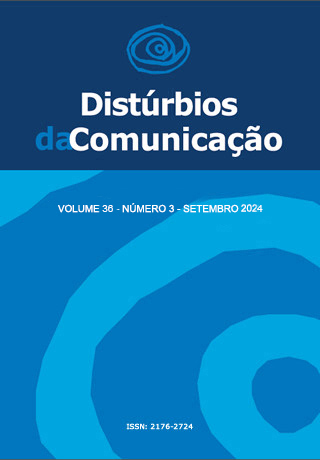Characteristics associated of family member’s perception regarding the importance of the Inmetro Noise Seal for children’s toys
DOI:
https://doi.org/10.23925/2176-2724.2024v36i3e67275Keywords:
Hearing Loss, Noise-Induced, Games and toys, Hearing, ChildAbstract
Introduction: Exposure to high sound pressure levels is a problem in modern society, especially among children. Purpose: To analyze the characteristics associated with family members’ perception of the importance of the Inmetro Noise Seal for children’s toys. Methods: Descriptive cross-sectional study with non-probabilistic convenience sampling. Data were collected through a questionnaire answered by parents and/or guardians of children between zero and five years of age. Results: The highest prevalence of individuals who knew the importance of the Inmetro Noise Seal was among guardians (66.7%), males (36.4%), aged 18 to 29 (37.5%), black (60.0%) and with up to one child (29.2%). The characteristic considered when buying a toy, which was most mentioned by participants, was the skill that the toy stimulates (92.3%). There was greater awareness of the importance of the Noise Seal among those who: considered the child’s hearing health when purchasing a toy (46.2%), considered Inmetro certification when purchasing a toy (41.7%), knew what hearing loss was (29.2%), had their children playing with noise-producing toys three to four days a week (40%) and did not buy toys without the seal (31.8%). The reported volume of toys obtained a median of five points, ranging from one to 10. Conclusion: Family members who knew the importance of the Inmetro Noise Seal took into account the child’s hearing health and Inmetro certification when purchasing a toy, when compared to others.
Downloads
References
Paunovic K. Noise and children′s health: research in central, eastern and south-eastern europe and newly independent states. Noise Health. 2013; 15(62):32.
Lim J, Kweon K, Kim HW, Cho SW, Park J, Sim CS. Negative impact of noise and noise sensitivity on mental health in childhood. Noise Health. 2018; 20(96):199-211.
Kamp, IV, Davies H. Noise and health in vulnerable groups: a review. Noise Health. 2013; 15(64): 153.
Lacerda ABM, Gonçalves CGO, Zocoli AMF, Diaz C, Paula K. Hábitos auditivos e comportamento de adolescentes diante das atividades de lazer ruidosas. Rev. CEFAC. 2010; 13(2): 322-29.
Weinreich HM, Jabbour N, Levine S, Yueh B. Limiting hazardous noise exposure from noisy toys: simple, sticky solutions. Laryngoscope. 2013; 123(9): 2240-4.
Organização Mundial da Saúde. Safe listening in video gaming & sports. OMS, 2023.
Sleifer P, Gonçalves MS, Tomasi M, Gomes E. Análise dos níveis de pressão sonora emitidos por brinquedos infantis. Rev. Paul. Pediatr. (Ed. Port., Online). 2013; 31(2): 218-22.
Penna LM, Lemos SMA, Alves, CRL. The lexical development of children with hearing impairment and associated factors. CoDAS. 2014; 26(3):193-200.
Instituto Nacional de Metrologia, Qualidade e Tecnologia. Portaria n. 563, de 29 de dezembro de 2016. [Brasília]: Ministério da Economia (BR); 2016.
Instituto Nacional de Metrologia, Qualidade e Tecnologia. Portaria n. 302, de 12 de julho de 2021. [Brasília]: Ministério da Economia (BR); 2021.
Ministério do Trabalho e Emprego. Aprova as NR do Capítulo V. Título II, da CLT, relativas à Segurança e Medicina do Trabalho. Portaria n. 3.214/78, de 8 de junho de 1978.
Taxini CL, Kinoshita SK, Guida HL. Análise acústica em brinquedos ruidosos. Rev. CEFAC. 2012;15(5):1098-107.
Ghavami Y, Bhatt J, Maducdoc M, Yau A, Mahboubi H, Ziai K. et al. Loudness and acoustic parameters of popular children’s toys. Int. J. Pediatr. Otorhinolaryngol. 2015; 79(12): 2086-9.
Ministério do Trabalho e Emprego. NR 15 - Atividades e Operações Insalubres. Brasília: Ministério do Trabalho e Emprego, 2014.
Estevam, GD. Poluição sonora e seus efeitos na saúde humana: estudo da Região Metropolitana de Campinas. 2012:68.
Instituto Nacional de Metrologia, Qualidade e Tecnologia. Portaria n. 563, de 29 de dezembro de 2016. [Brasília]: Ministério da Indústria, Comércio Exterior e Serviços (BR); 2016.
Jabbour N, Weinreich HM, Owusu J, Lehn M, Yueh B, Levine S. Hazardous noise exposure from noisy toys may increase after purchase and removal from packaging: a call for advocacy. Int. J. Pediatr. Otorhinolaryngol. 2019; 116: 84-7.
Santana BA, Alvarenga KF, Cruz PC, Quadros IA, Jacob-Corteletti LCB. Prevenção da perda auditiva no contexto escolar frente ao ruído de lazer. Audiol. Commun. Res. 2016; 21: 327-45.
Feder K, Marro L, Portnuff C. Leisure noise exposure and hearing outcomes among Canadians aged 6 to 79 years. Int. J. Audiol. 2022:1-17.
Instituto Brasileiro do Meio Ambiente e dos Recursos Naturais Renováveis. [homepage da internet]. 2022. [acesso em: 5 de fevereiro de 2024]. Disponível em: https://www.gov.br/ibama/pt-br/servicos/autorizacoes/selo-ruido#sobre-o-selo-ru-do.
Gupta A, Gupta A, Jain K, Gupta S. Noise pollution and impact on children’s health. Indian J. Pediatr. 2018; 85(4): 300-6.
Anastasios G, Magioula G, Konstantinos K, Ioannis A. Noise and health: review. Indian J. Otolaryngol. Head Neck Surg. 2021; 74(3): 5482-91.
Downloads
Published
Issue
Section
License
Copyright (c) 2024 Dra. Fernanda Zucki, Dra. Danúbia Hillesheim, Fga. Michelle Vieira Felix

This work is licensed under a Creative Commons Attribution 4.0 International License.









